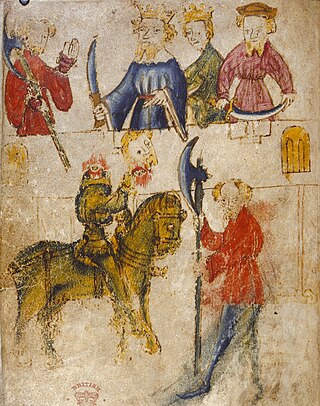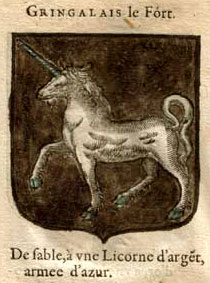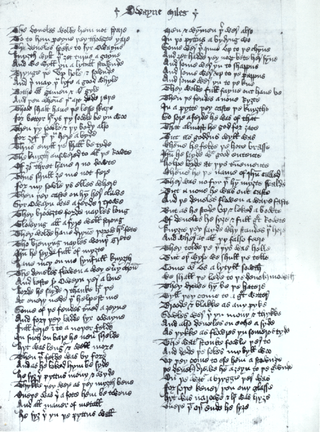Related Research Articles

Sir Orfeo is an anonymous Middle English Breton lai dating from the late 13th or early 14th century. It retells the story of Orpheus as a king who rescues his wife from the fairy king. The folk song Orfeo is based on this poem.

The Knights of the Round Table are the legendary knights of the fellowship of King Arthur that first appeared in the Matter of Britain literature in the mid-12th century. The Knights are an order dedicated to ensuring the peace of Arthur's kingdom following an early warring period, entrusted in later years to undergo a mystical quest for the Holy Grail. The Round Table at which they meet is a symbol of the equality of its members, who range from sovereign royals to minor nobles.

The Green Knight is a heroic character of Arthurian legend, originating in the 14th-century poem Sir Gawain and the Green Knight and the related medieval work The Greene Knight. His true name is revealed to be Bertilak de Hautdesert in Sir Gawain, while The Greene Knight names him "Bredbeddle". The Green Knight later features as one of Arthur's greatest champions in the fragmentary ballad "King Arthur and King Cornwall", again with the name "Bredbeddle".

Bevis of Hampton (Old French: Beuve(s) or Bueve or Beavisde Hanton(n)e; Anglo-Norman: Boeve de Haumtone; Italian: Buovo d'Antona) or Sir Bevois, was a legendary English hero and the subject of Anglo-Norman, Dutch, French, English, Venetian, and other medieval metrical chivalric romances that bear his name. The tale also exists in medieval prose, with translations to Romanian, Russian, Dutch, Irish, Welsh, Old Norse and Yiddish.

As a literary genre, the chivalric romance is a type of prose and verse narrative that was popular in the noble courts of high medieval and early modern Europe. They were fantastic stories about marvel-filled adventures, often of a chivalric knight-errant portrayed as having heroic qualities, who goes on a quest. It developed further from the epics as time went on; in particular, "the emphasis on love and courtly manners distinguishes it from the chanson de geste and other kinds of epic, in which masculine military heroism predominates."
Sir Launfal is a 1045-line Middle English romance or Breton lay written by Thomas Chestre dating from the late 14th century. It is based primarily on the 538-line Middle English poem Sir Landevale, which in turn was based on Marie de France's lai Lanval, written in a form of French understood in the courts of both England and France in the 12th century. Sir Launfal retains the basic story told by Marie and retold in Sir Landevale, augmented with material from an Old French lai Graelent and a lost romance that possibly featured a giant named Sir Valentyne. This is in line with Thomas Chestre's eclectic way of creating his poetry.
Sir Aldingar is Child ballad 59. Francis James Child collected three variants, two fragmentary, in The English and Scottish Popular Ballads. All three recount the tale where a rebuffed Sir Aldingar slanders his mistress, Queen Eleanor, and a miraculous champion saves her.
Romance of Horn is an Anglo-Norman literature romans d'aventure tale written around 1170 by an author apparently named "Thomas". The story became the basis for one of the earliest Middle English romances, King Horn, written around 1225.

Sir Gingalain, also known as Le Bel Inconnu, or The Fair Unknown, is a character from Arthurian legend whose exploits are recorded in numerous versions of a popular medieval romance. His nickname differs depending on the version and language; he is known in English as Libeaus Desconus. He is the title character in Le Bel Inconnu, a poem composed by Renaut de Beaujeu sometime between the mid-1180s and 1230, and in the (destroyed) 13-century manuscript, Gliglois. It is uncertain, however, if the Gliglois of the medieval manuscript refers to Gawain's son or some other character in the "Fair Unknown" cycle.

Sir Ywain, also known as Yvain and Owain among other spellings, is a Knight of the Round Table in Arthurian legend, wherein he is often the son of King Urien of Gorre and either the enchantress Modron or the sorceress Morgan le Fay. The historical Owain mab Urien, on whom the literary character is based, was the king of Rheged in Great Britain during the late 6th century.
Libeaus Desconus is a 14th-century Middle English version of the popular "Fair Unknown" story. Its author is thought to be Thomas Chestre. The story matter displays strong parallels to that of Renaut de Beaujeu's Le Bel Inconnu; both versions describe the adventures of Gingalain, the son of King Arthur's knight Gawain and a fay who raises him ignorant of his parentage and his name. As a young man, he visits Arthur's court to be knighted, and receives his nickname; in this case Sir Libeaus Desconus, before setting forth on a series of adventures which consolidate his new position in society. He eventually discovers who is his father, and marries a powerful lady.

Brunor, Breunor, Branor or Brunoro are various forms of a name given to several different characters in the works of the Tristan tradition of Arthurian legend. They include Knight of the Round Table known as Brunor/Breunor le Noir, as well as his father and others, among them another former knight of Uther's old Round Table and the father of Galehaut.
"King Arthur and King Cornwall" is an English ballad surviving in fragmentary form in the 17th-century Percy Folio manuscript. An Arthurian story, it was collected by Francis James Child as Child Ballad 30. Unlike other Child Ballads, but like the Arthurian "The Boy and the Mantle" and "The Marriage of Sir Gawain", it is not a folk ballad but a professional minstrel's song. It is notable for containing the Green Knight, a character known from the medieval poems The Greene Knight and the more famous Sir Gawain and the Green Knight; he appears as "Bredbeddle", the character's name in The Greene Knight.

Octavian is a 14th-century Middle English verse translation and abridgement of a mid-13th century Old French romance of the same name. This Middle English version exists in three manuscript copies and in two separate compositions, one of which may have been written by the 14th-century poet Thomas Chestre who also composed Libeaus Desconus and Sir Launfal. The other two copies are not by Chestre and preserve a version of the poem in regular twelve-line tail rhyme stanzas, a verse structure that was popular in the 14th century in England. Both poetic compositions condense the Old French romance to about 1800 lines, a third of its original length, and relate “incidents and motifs common in legend, romance and chanson de geste.” The story describes a trauma that unfolds in the household of Octavian, later the Roman Emperor Augustus, whose own mother deceives him into sending his wife and his two newborn sons into exile and likely death. After many adventures, the family are at last reunited and the guilty mother is appropriately punished.

Sir Eglamour of Artois is a Middle English verse romance that was written sometime around 1350. It is a narrative poem of about 1300 lines, a tail-rhyme romance that was quite popular in its day, judging from the number of copies that have survived – four manuscripts from the 15th century or earlier and a manuscript and five printed editions from the 16th century. The poem tells a story that is constructed from a large number of elements found in other medieval romances. Modern scholarly opinion has been critical of it because of this, describing it as unimaginative and of poor quality. Medieval romance as a genre, however, concerns the reworking of "the archetypal images of romance" and if this poem is viewed from a 15th-century perspective as well as from a modern standpoint – and it was obviously once very popular, even being adapted into a play in 1444 – one might find a "romance [that] is carefully structured, the action highly unified, the narration lively."
Sir Gawain and the Carle of Carlisle is a Middle English tail-rhyme romance of 660 lines, composed in about 1400. A similar story is told in a 17th-century minstrel piece found in the Percy Folio and known as The Carle of Carlisle. These are two of a number of early English poems that feature the Arthurian hero Sir Gawain, the nephew of King Arthur, in his English role as a knight of the Round Table renowned for his valour and, particularly, for his courtesy.
Sir Perceval of Galles is a Middle English Arthurian verse romance whose protagonist, Sir Perceval (Percival), first appeared in medieval literature in Chrétien de Troyes' final poem, the 12th-century Old French Conte del Graal, well over one hundred years before the composition of this work. Sir Perceval of Galles was probably written in the northeast Midlands of England in the early 14th century, and tells a markedly different story to either Chretien's tale or to Robert de Boron's early 13th-century Perceval. Found in only a single manuscript, and told with a comic liveliness, it omits any mention of a graal or a Grail.
Roswall and Lillian is a medieval Scottish chivalric romance. A late appearing tale, it nevertheless draws heavily on folkloric motifs for its account of an exiled prince, reduced to poverty, who rises from it to win a princess.
Sir Degaré is a Middle English romance of around 1,100 verse lines, probably composed early in the fourteenth century. The poem is often categorised as a Breton lai because it is partly set in Brittany, involves an imagined Breton royal family, and contains supernatural elements similar to those found in some other examples, such as Sir Orfeo. Sir Degaré itself does not explicitly claim to be a Breton lai. The poem is anonymous, and no extant source has ever firmly been identified.
Moriaen is a 13th-century Arthurian romance in Middle Dutch. A 4,720-line version is preserved in the vast Lancelot Compilation, and a short fragment exists at the Royal Library at Brussels. The work tells the story of Morien, the Moorish son of Aglovale, one of King Arthur's Knights of the Round Table.
References
- Ebbutt, M.I. & John Mattrews (Editor) (1995). Hero Myths & Legends of Britain & Ireland. Blandford Press. ISBN 0-7137-2532-X
- Attribution
- This article incorporates text from a publication now in the public domain : Chisholm, Hugh, ed. (1911). "Horn (hero)". Encyclopædia Britannica . Vol. 13 (11th ed.). Cambridge University Press. pp. 696–697.